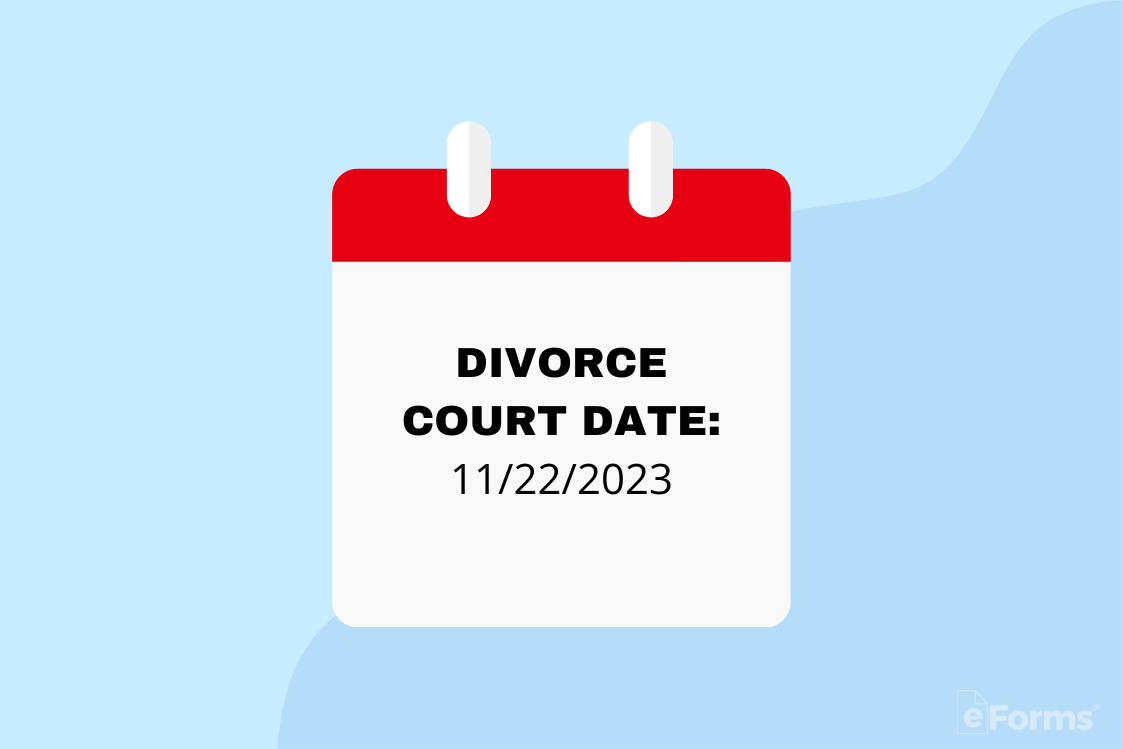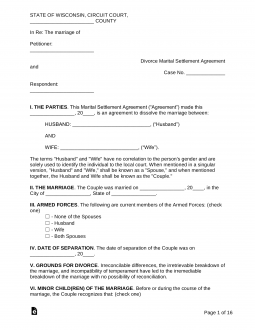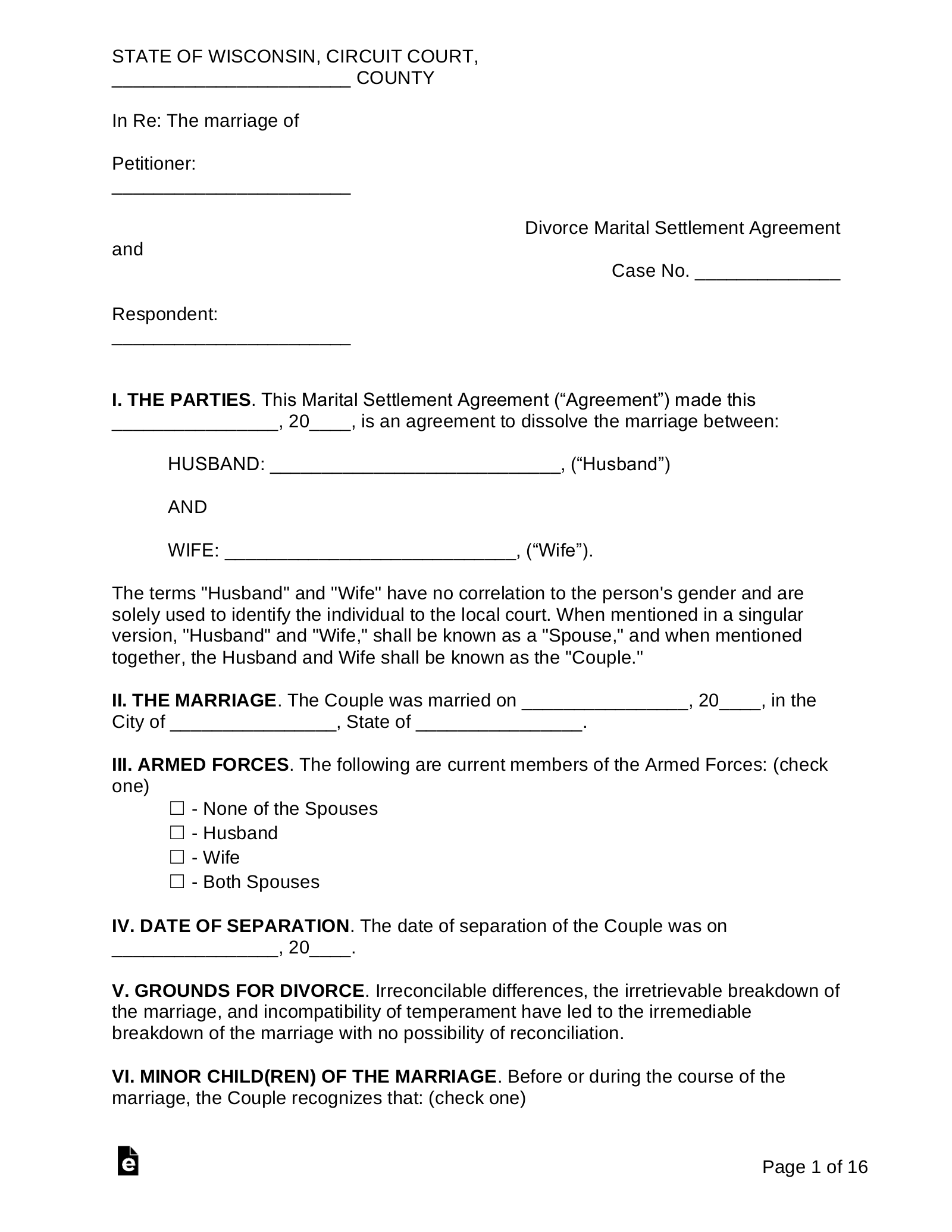Updated August 30, 2023
A Wisconsin marital settlement agreement is used to delineate the division of assets and responsibilities between spouses after their divorce is finalized. This agreement enables the couple to negotiate terms and allows them to come to a conclusion about the allocation of property, the payment of child and spousal support, and the custody of any minor children without relying on the court’s decision. The presence of such a document in a divorce case implies that it is uncontested; that is, that both parties agree to everything in the divorce before any final hearing or trial.
Table of Contents |
Divorce Laws
Statutes
- Subch. IV of CH. 767 – (Annulment, Divorce, and Legal Separation)
- Subch. V of Ch. 767 – (Child Custody, Placement, and Visitation)
- Subch. VI of Ch. 767 (Support and Maintenance)
Alimony (§ 767.56) – The court may award either party spousal support (alimony) in the amount they deem just and fair. They will take the following into account when granting their order:
- The length of the marriage;
- The health and age of both spouses;
- Property division;
- The education of both spouses;
- The earning capacity of each party and the investment required to find appropriate employment;
- The ability for the party seeking maintenance to become financially independent, and the length of time required to gain independence;
- Any mutual agreement drafted by the parties;
- The contributions of one party to the earning capacity of the other;
- Any other factors the court deems relevant.
Alimony Calculator – sterlinglawyers.com
Child Support (§ 767.511) – The courts will determine the amount of child support that each party must pay by calculating a percentage of the gross income and assets of both individuals (Child Support Percentage Conversion Table). A deviation from the standard may occur in consideration of the following:
- The child’s financial resources;
- Spousal maintenance;
- The needs of each party;
- The needs of any other person either spouse is obligated to support;
- The standard of living while married;
- Whether the custodian is staying at home full time;
- Cost of child care if custodian works outside the home;
- The award of periods of physical placement to both parties;
- Necessary travel expenses;
- Educational needs;
- Tax consequences;
- The best interests of the child;
- Each party’s earning capacity;
- Any other relevant factors.
Child Support Calculator – sterlinglawyers.com
Division of Property (§ 767.61) – Wisconsin is a community property state, which means that the court tends to divide the property equally between the parties. An alteration in the distribution of marital property can occur in consideration of the factors listed in § 767.61(3).
Grounds for Divorce (§ 767.315) – In Wisconsin, the grounds for divorce are simply that the marriage is “irretrievably broken.” This can be demonstrated through their separation of at least twelve (12) months or through a statement under oath or affirmation.
Interim Support (§ 767.57(1)(a)) – Either party may file an order to receive interim support, also called temporary maintenance, in order to receive payments from the other spouse through the divorce proceedings.
Residency (§ 767.301) – A divorce will not be processed unless one (1) of the spouses has been a resident of the county in which they are filing for at least thirty (30) days preceding the action, and a resident of Wisconsin for at least six (6) months.
Separation (§ 767.315) – The couple may indicate that the marriage is irretrievably broken by living separately and apart for a period of twelve (12) months or more. However, this is not the only manner of demonstrating grounds for divorce.
Divorce Forms
- Where to File – Circuit Court
- Filing Fee – ~$150 (source: sterlinglawyers.com)
- How Long Does it Take? – At least 120 days.
Uncontested Divorce with No Children:
- Joint Petition without Minor Children – FA-4111V
- Confidential Petition Addendum – GF-179
- Stipulation for Temporary Order without Minor Children – FA-4127VA
- Temporary Order without Minor Children – FA-4127VB
- Financial Disclosure Statement – FA-4139V
- Findings of Fact, Conclusions of Law, and Judgment without Minor Children – FA-4161VA
- Marital Settlement Agreement Without Minor Children – FA-4151V
- Vital Statistics Form (from the Clerk of Circuit Court office)
Uncontested Divorce with Children:
- Joint Petition with Minor Children – FA-4110V
- Confidential Petition Addendum – GF-179
- Stipulation for Temporary Order with Minor Children – FA-4126VA
- Temporary Order with Minor Children – FA-4126VB
- Financial Disclosure Statement – FA-4139V
- Proposed Parenting Plan – FA-4147V
- Findings of Fact, Conclusions of Law, and Judgment with Minor Children – FA-4160VA
- Marital Settlement Agreement With Minor Children – FA-4150V
- Vital Statistics Form (from the Clerk of Circuit Court office)
How to File for Divorce in Wisconsin (8 steps)
- Complete Joint Petition
- Stipulation for Temporary Order
- File Documents
- Parenting Plan and Classes (if applicable)
- Schedule Final Hearing
- Marital Settlement Agreement and Final Documents
- Final Hearing
- Name Change
Wisconsin residents can choose to complete the majority of the court documents online through an automated interview on the government website. The below instructions will concern those who opt not to take that route.
1. Complete Joint Petition

In an uncontested case wherein both parties agree to get a divorce, the recommended course of action is that both spouses file a joint petition together. The parties will want to complete either a Joint Petition without Minor Children – FA-4111V or a Joint Petition with Minor Children – FA-4110V to get started. They’ll also want to complete a Confidential Petition Addendum – GF-179, following the instructions on the left-hand side of the document.
2. Stipulation for Temporary Order
3. File Documents
4. Parenting Plan and Classes (if applicable)

Some counties require that parents attend classes before the final hearing to ensure that they’re prepared to raise their children post-divorce. They may also demand that the parents draft and sign a Proposed Parenting Plan – FA-4147V wherein they detail the manner in which they’ll share custody and contribute to the child’s upbringing financially and otherwise.
5. Schedule Final Hearing
6. Marital Settlement Agreement and Final Documents
- Financial Disclosure Statement – FA-4139V
- Both parties should complete a statement to provide the court with a detailed accounting of their financial circumstances.
- Marital Settlement Agreement (state-government version: with children|without children)
- Relays the couple’s agreement on all divorce terms to be approved in the final hearing.
- Vital Statistics Form
- Can be obtained at the Clerk of Circuit Court office. Used to report the divorce.
- Findings of Fact, Conclusions of Law, and Judgment (with children|without children)
- To be completed by the judge as the final form that sets out the facts and judgment of the case.
7. Final Hearing

Both parties should show up on time to their hearing with the final documents in hand. The judge will review all the documents and, if they approve the settlement agreement, they’ll complete the judgment form granting the divorce. The couple will be required to complete any other post-judgment forms the court deems necessary.


